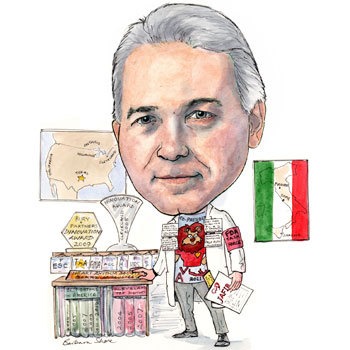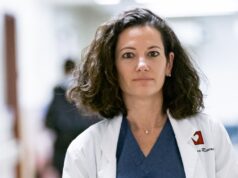
Andrea Natale, executive medical director at the Texas Cardiac Arrhythmia Institute, St David’s Medical Center, Austin, USA, and co-president of Venice Arrhythmias (9–12 October 2011) talks to Cardiac Rhythm News about who inspired him to go into electrophysiology and what drives him today.
What made you go into medicine and, specifically, why did you choose to specialise in electrophysiology?
My father was a strong influence in my decision to choose cardiology for my career. Then very early in my cardiology training, I was fortunate enough to meet Pietro Santarelli, who was at the time the leading electrophysiologist at the Catholic University [in Italy, where Andrea Natale studied cardiology]. He got me interested in the field of electrophysiology, which I found very intellectually challenging and stimulating. Also, I became interested in electrophysiology because I realised it was a field in its infancy that offered a full range of expanding investigations.
Who or what has had the greatest influence on your career?
My father; as a physician, he was an example of dedication to his patients and to medicine. Dr Santarelli was an important influence because he inspired my interest in the field of electrophysiology. Also, George Klein and Masood Akhtar had a very strong influence as my teachers and mentors. I am very grateful for their humanity, dedication to teaching, and for their rigorous approach to understanding arrhythmias. They still have a strong influence on my career today. I really feel that they were instrumental in moulding my career and who I am today.
How has the field of cardiac electrophysiology developed during your career?
While the basic electrophysiologic principles for the diagnosis and interpretation of cardiac arrhythmias have not substantially changed over the years, outstanding technical evolutions have greatly advanced the field of clinical cardiac electrophysiology and improved the outcomes of catheter ablation and device-based therapies. Among these, the introduction of 3D cardiac mapping systems has improved the understanding of the mechanisms and substrates of complex cardiac arrhythmias. Additionally, technical advancements of ablation technologies have contributed to the increased safety and effectiveness of ablation procedures, and the introduction of remote navigation systems has reduced the operator-dependency of manual procedures.
Similarly, the advent of cardiac resynchronisation therapy (CRT) has revolutionised the management of certain patients with heart failure, providing a treatment that not only reverses the deterioration associated with different cardiomyopathies but also prevents the progression of such diseases.
As someone who has pioneered a new circumferential ultrasound vein-ablation system, developed some of the current catheter-based cures for atrial fibrillation, and who was the first electrophysiologist in the USA to perform percutaneous epicardial radiofrequency ablation, you certainly have several moments in your career to be proud of. What have been your proudest achievements and why?
During my training in electrophysiology, the invasive treatment of atrial fibrillation was only a “dream”. It was like the Galileo theory of the planets. I had the opportunity to “live” the era of the first transseptal catheterisation for the ablation of the pulmonary vein triggers. I feel fortunate that I was able to contribute to the field by pioneering one of the approaches to ablation of atrial fibrillation and being able to be involved in the development of many of the technologies that are available today. I am also very passionate about treating every patient to the best of my ability, with compassionate and professional care.
On your website (https://andreanatale.com), you say that upon running into a wall (when treating a patient), that you “thoughtfully plough through the wall”. What type of walls do you come across and can you give an example of when you successfully “ploughed through”?
I always approach every case with humbleness and an open mind. No matter what I am dealing with, “never give up” is my motto. This has allowed me over the years to find ways to treat patients with long-standing persistent atrial fibrillation and patients with challenging accesses such as those with atrial septal closure devices.
As co-president of Venice Arrhythmias, what is the main aim of the conference in 2011? What will be new compared with previous conferences?
Venice Arrhythmias is now in its 12th edition. Since its first edition in 1989, the meeting has expanded rapidly and become one of the most acknowledged and prestigious platforms for professional development and networking in the field of cardiac arrhythmias. In line with the earlier editions, all the aspects of cardiac arrhythmias, from epidemiology, pathophysiology, natural history, to diagnosis, prognosis and treatment, will be simultaneously dealt with in 11 different rooms by more than 350 invited speakers. We are also holding several debates, which will review unresolved and controversial issues. However, the main part of the programme will focus on the 2011 update of Venice Chart on atrial fibrillation ablation, which has involved a large group of experts worldwide.
Another new aspect is that the most prestigious scientific societies operating in the field of cardiac arrhythmias, such as the Heart Rhythm Society and the European Heart Rhythm Association, have been more deeply involved in the preparation of this year’s scientific programme than in previous years.
Additionally, the 2011 congress will feature brand new geographic corner sessions that have been prepared by leading experts from emerging areas such as China, India, South America and the Middle East to reflect the expansion of research throughout the world.
Together with the president of Venice Arrhythmias Antonio Raviele, you will be chairing a series of symposia on atrial fibrillation. In your view, what is the key message about the management of atrial fibrillation in 2011?
While all aspects of atrial fibrillation will be discussed, special attention will be devoted to the ablation of atrial fibrillation, as well as the new antiarrhythmic drugs and oral anticoagulation drugs.
A special panel will focus on dronedarone (Multaq, Sanofi Aventis), vernakalant (Brinavess, Cardiome Pharma Corp and MSD), and the new oral anticoagulation drugs-such as rivaroxaban (Xarelto, Johnson & Johnson) and dabigatran (Pradaxa, Boehringer Ingelheim). Regarding dabigatran, we will talk of its use as an alternative to warfarin and its use in particular clinical cases, such as transcatheter ablation without dabigatran discontinuation.
We will also focus on the newest technologies, like cryoballoon ablation, laser ablation and the new radiofrequency catheters with contact sensors. Alongside these, all other techniques employed mostly to increase the efficacy of the ablation treatment in patients with long-standing persistent atrial fibrillation will be reviewed and compared.
However, if I were to point out a key message, I think it would be that we are geared towards a standardisation of the ablative approach of atrial fibrillation and we are becoming increasingly more aware of its efficacy. The experience gained so far has led to a Class 1 recommendation in patients without cardiac diseases or with cardiac disease associated with paroxysmal or persistent atrial fibrillation. Finally, the consensus document (Venice Chart) will discuss ablation as a first choice treatment in patients with paroxysmal atrial fibrillation.
Catheter ablation for atrial fibrillation has become increasingly popular, but there is limited long-term data for this therapy. Do you think as time goes on and as more data become available, and perhaps as different types of ablation are developed and fine tuned, more and more patients will be treated with catheter ablation?
Compelling evidence derived from multiple randomised trials favours the adoption of curative catheter ablation procedures for patients with symptomatic atrial fibrillation who have failed treatment with antiarrhythmic drugs. Accordingly, the latest release of the guidelines for the treatment of atrial fibrillation has upgraded the indication to catheter ablation to Class I, with the highest level of evidence.
Several observational studies have confirmed quite high success rates even at long-term follow-up, especially after more than one procedure. As techniques advance and operators become more expert, it is entirely plausible that more and more patients will receive catheter ablation.
For instance, there is already evidence supporting catheter ablation as a first-line, rhythm control therapy for atrial fibrillation, and a large ongoing trial (RAAFT-2; Catheter ablation vs. antiarrhythmic drugs as first line therapy for paroxysmal atrial fibrillation) is further evaluating the benefit of catheter ablation in this sense.
What types of catheter ablation are you most interested in and why?
The type of atrial fibrillation that I am most interested in is for long-standing persistent atrial fibrillation. This is the most difficult type of atrial fibrillation to be treated because together with the isolation of the pulmonary veins, non-pulmonary vein triggers need to be taken into account and need to be ablated. A great deal of my research activities have been devoted to finding better ways to achieve a higher success rate in treating these types of arrhythmias. Over time, I have developed my own approach that I enjoy teaching to my fellows and partners.
In 2009, Cardiac Rhythm News invited you to take the side of robotic navigation, compared with magnetic navigation, for catheter ablation. You said robotic navigation for atrial fibrillation ablation, compared with magnetic navigation, met the need for easier navigation at a lower cost while preserving the workflow of standard manual procedures. Do you still agree with this view?
Some of the concepts expressed in favour of robotic navigation are still valid in terms of easier navigation and preservation of the workflow.
Although, it is fair to say that magnetic navigation with the introduction of new software and the magnetic irrigated 3.5mm tip catheter has significantly improved and now it is very competitive.
Outside of medicine, what are your hobbies and interests?
Unfortunately, my job is also my hobby and it does not leave much time to anything else. But I do enjoy skiing and spending time with my family.
Fact File
Professional appointments (selected)
2008–present Executive medical director of the Texas Cardiac Arrhythmia Institute at St David’s Medical Center, Austin, USA
2008–present Clinical associate professor of medicine, Case Western Reserve University, Cleveland, Ohio, USA
2007–present Co-president, Venice Arrhythmias
2005–present Consulting professor, Division of Cardiology, Stanford University, Palo Alto, California, USA
Education
1985–1989 School of Cardiology, Catholic University of the Sacred Heart, Rome, Italy
1979–1985 Medical school, University of Florence, Italy
Research fellowships
1989–1990 Research fellow in cardiology, University of Western Ontario, Canada
1991–1992 Clinical fellow in cardiology (electrophysiology), University of Western Ontario, Canada
1992–1993 Clinical fellow in cardiology (electrophysiology), University of Wisconsin, Sinai Samaritan Medical Center, Milwaukee, USA
Honours (selected)
2011, elected to the Heart Rhythm Society Board of Trustees
Since 2003, nominated among The “Best Doctors” in America
2003–2008, nominated among “Top Doctors” in Cleveland
2009, Nominated among the “Best Doctors” in Austin
2003, 2004, and 2005, The Cleveland Clinic Innovator Award
2009, Texas Cardiac Arrhythmia Institute at St David’s Medical Center received The Bury + Partners Innovation Award, Austin,USA
Memberships
2010 Fellowship of the European Society of Cardiology
2008–present Texas Medical Association
2006–present Fellow of the American College of Cardiology
2005–present American Medical Association
2003–present American Heart Association
2006–present Heart Rhythm Society Member; fellow of the Heart Rhythm Society












